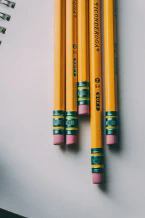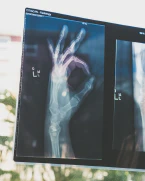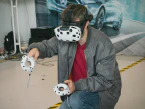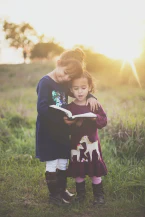Trusting Kid''s Independence

The Safety-Danger Balance in Parenting: Finding the Middle Ground
Growing up, I remember being given the freedom to explore my surroundings and take risks. My friends and I would spend hours outside, playing games and venturing into unknown territories without adult supervision. It was a different time, and as I look around at the world today, I can see how things have changed.
Parents today seem to be more anxious and worried about the safety of their children than ever before. While it’s understandable to want to protect our little ones, we may be doing more harm than good by not allowing them to take risks and learn from their mistakes.
When I take my children to the playground, I often see other parents hovering over their kids, shouting “Be careful, be careful, be careful!” at every turn. While it’s natural to want to protect our children from harm, we must remember that they need to take risks in order to learn and grow.
Children need to be able to stumble, fall, and make mistakes in order to learn the limitations of their bodies and the world around them. If we never allow them to take risks, they may never learn how to crawl, roll over, or walk. No baby has ever learned to walk without falling down. The same is true for any learning curve.
Of course, we must still keep our children safe and protect them from real dangers. But we must also allow them to take risks and make their own decisions within safe boundaries. By doing so, we can help them develop good judgment and decision-making skills, which will serve them well as they grow older.
As parents, we can grow a message of trust and skill-building by giving our children the space to explore and take risks. Instead of constantly saying “Be careful,” we can give them useful information that will help them make informed decisions. We can also develop mantras that encourage trust, such as “I trust you” or “I see that you know how to stay safe.”
In the end, it’s important to strike a balance between safety and danger when it comes to parenting. We must allow our children to take risks and learn from their mistakes, while still keeping them safe from real dangers. By doing so, we can help them develop into confident, independent adults who are capable of making good decisions on their own.
How Our Society Has Become Addicted to Anxiety as Parents
As parents, we want nothing more than to keep our children safe from harm. However, in today’s society, it seems as though anxiety has become an addiction. We constantly worry about our children’s safety, from the dangers of pedophilia to the risk of catching a cold.
When we take our children to the playground, we see other parents hovering over their kids, shouting “Be careful, be careful, be careful!” at every step. While it’s understandable to want to protect our children from harm, we must remember that they need to take risks in order to learn and grow.
Children need to be able to stumble, fall, and make mistakes in order to learn the limitations of their bodies and the world around them. If we never allow them to take risks, they may never learn how to crawl, roll over, or walk. No baby has ever learned to walk without falling down. The same is true for any learning curve.
Furthermore, we need to be aware of the messages we’re sending to our children. If we’re constantly shouting “Be careful,” we’re sending the message that they can’t be trusted to make their own decisions. This can lead to a lifetime of anxiety and timidity, as they become too afraid to take risks and make mistakes.
The truth is, real dangers for children are few and far between. Living in a worst-case scenario all the time is called catastrophic thinking, and it’s a pretty miserable way to live. Instead, we need to grow a message of trust and skill-building, by giving our children the space to explore and take risks within safe boundaries.
We need to realize that worrying is not our job as parents. It’s important to strike a balance between safety and risk-taking, by allowing our children to take risks and learn from their mistakes while still keeping them safe from real dangers. By doing so, we can help them develop into confident, independent adults who are capable of making good decisions on their own.
If you’re struggling to find this balance in your own parenting journey, there are resources available that can help. Reading books like “Free to Learn” by Dr. Peter Gray or “Playborhood” can provide valuable insights into the importance of risk-taking and play in child development.
In the end, it’s important to remember that anxiety is contagious, and our children look to us to determine whether a situation is safe or not. By growing a message of trust and skill-building, we can help our children develop into confident, independent adults who are capable of making good decisions on their own.
The Importance of Allowing Children to Take Risks and Make Mistakes
As parents, we always want to keep our children safe from harm. It’s natural to want to protect them from danger and shield them from risks. However, this overprotectiveness can be counterproductive in their development.
Kids need to take risks and make mistakes in order to learn and grow. They need to stumble and fall, and do things that might be perceived as dangerous and scary by their parents. This is how they learn the limitations of their bodies and of the world.
If we don’t allow them to take risks, they’ll never learn to crawl, roll over, walk, or climb. No baby has ever learned to walk without falling down. And the same is true for any learning curve - it includes stumbling, falling, and risk-taking.
It’s important to let children make small mistakes when they’re young, so they can learn from them and avoid making bigger mistakes when they’re older. When kids feel like they need constant protection, they might become timid and anxious all the time.
Parents need to understand that real dangers are few and far between. Living in a worst-case scenario all the time is called catastrophic thinking. It means always imagining the worst and it’s a pretty miserable way to live.
As children grow up, the risks they take become more serious. So, rather than piling all the independence on them all at once, we need to build it up in a way that’s appropriate to their maturity level. By practicing good judgment and making small mistakes when they’re small, they can save themselves from making big mistakes when they’re big.
It’s also important to create a safe environment for children to take risks. Parents should allow their children to do the things they’re interested in and stretch their capabilities. For example, if they’re interested in cooking, parents should find a way to allow them to cook in a safe and appropriate way for their skill and maturity level.
Failure is our most important teacher. Where failure isn’t too great or too risky, we should allow our children to take the full risk and fail if necessary. It’s through these experiences that they’ll develop a sense of trust in their own body and limits.
Letting children take risks can be scary for parents, but it’s important to grow trust and a sense of responsibility in them. We should encourage trust by giving them useful information and refraining from constantly saying “Be careful.” Instead, we can ask them if they feel safe doing something, and develop their judgment about what is and isn’t safe.
In conclusion, allowing children to take risks and make mistakes is crucial for their development. It’s our job as parents to create a safe environment for them to take risks, learn, and grow. By doing so, we can help them build trust, good judgment, and a sense of responsibility.
The Tragic Loss of Childhood Freedom and Independence
As a society, we seem to have lost something precious - the childhood freedom and independence that we once had. Children used to be able to roam the streets and play outside with their friends without constant adult supervision. They were given the space to take risks and make mistakes, which helped them develop their independence and self-reliance. But today, things are different.
Many parents are afraid to let their children out of their sight, and they hover over them constantly, warning them to be careful and avoid any perceived danger. This culture of anxiety has created a generation of children who are timid and anxious, always looking to their parents for guidance and protection. But this overprotectiveness can actually be harmful to their development.
Children need to take risks and make mistakes in order to learn and grow. They need to be given the space to explore their environment and learn about the world around them. This means letting them play outside without constant adult supervision and allowing them to take on tasks that may seem dangerous, like climbing a tree or using a knife to help with cooking.
Of course, safety is important, and parents should take reasonable precautions to protect their children. But it’s also important to recognize that real dangers are actually quite rare, and that children are capable of learning how to stay safe and make good decisions on their own. By giving them the space to take risks and make mistakes when they’re young, we’re helping them build the skills and confidence they need to make good decisions as they grow up.
So let’s work to create a culture of trust and independence, where children are given the space to take risks and make mistakes, and where parents can feel confident in their children’s ability to navigate the world. Let’s give our children the childhood freedom and independence that we once had, so that they can grow up to be self-reliant, confident, and capable adults.
Growing Trust in Our Children and Ourselves as Parents
As parents, we often find ourselves consumed by worry and anxiety over our children’s safety. We hover over them, warning them to be careful and shielding them from any potential danger. However, this can have a negative impact on our children’s development and growth.
It’s essential to grow trust in our children and ourselves as parents. We need to allow our children to take risks, make mistakes, and learn from them. When we trust our children, we enable them to make decisions and develop their judgment.
One way to grow trust is by giving children the freedom to explore their interests and passions. Suppose your child is interested in cooking, for instance. In that case, you should work with them to create a safe and appropriate environment for them to use knives and cook safely according to their skill and maturity level.
Instead of saying “Be careful” all the time, try giving them useful information that can help them make better decisions. For instance, instead of shouting, “Be careful, that wall is high,” say, “That wall looks high; be sure to grip it tightly.”
If you’re worried about their safety, you can look away if necessary, as long as you think the situation is safe and within their realm of capability.
We need to build trust in our children, rather than instilling fear and anxiety in them. This means allowing them to take ownership of their own freedom and development, taking risks, and learning from their mistakes. By growing trust in our children, we enable them to become independent and responsible adults.
Developing Good Judgment and Making Small Mistakes as a Learning Curve
As parents, it’s natural to want to protect our children from harm and steer them away from making mistakes. However, it’s important to remember that making small mistakes and experiencing the consequences is an essential part of learning and developing good judgment.
When children are allowed to make mistakes, they are given the opportunity to learn from them and develop critical thinking skills. This can be especially important in situations where there are no clear right or wrong answers. By allowing children to make decisions and learn from the consequences, they are able to develop their own sense of judgment and problem-solving skills.
It’s also important to recognize that mistakes, especially small ones, are a natural part of the learning curve. Children should not be made to feel ashamed or embarrassed about their mistakes, but rather encouraged to reflect on them and learn from them. This helps build toughness and a growth mindset in children, which can be invaluable in their future endeavors.
As parents, it’s our responsibility to create a safe and supportive environment where our children can learn from their mistakes without fear of judgment or punishment. By doing so, we help them develop the confidence and self-assurance needed to make good decisions and navigate the challenges of life.
Creating a Safe Environment for Kids to Take Risks and Build Independence
Allowing children to take risks and make mistakes is an important part of their development, but as parents, it can be difficult to strike a balance between safety and freedom. Creating a safe environment where children can take risks and build independence is crucial.
One way to create a safe environment is to provide children with clear boundaries and rules. This gives them a sense of structure and helps them understand what is expected of them. It also allows parents to set limits on what is safe and appropriate.
Another way to create a safe environment is to allow children to learn through trial and error. This means giving them the opportunity to make mistakes and learn from them, rather than always stepping in to solve their problems for them. By doing so, parents can help their children build toughness and problem-solving skills.
It’s also important for parents to model safe behavior and teach their children how to assess risk. This can be done through age-appropriate discussions and activities that help children understand the consequences of their actions.
Finally, creating a safe environment means being aware of potential hazards and taking steps to minimize them. This could include childproofing the home, teaching children how to use equipment safely, and supervising them appropriately.
In summary, creating a safe environment for kids to take risks and build independence involves setting clear boundaries, allowing children to learn through trial and error, modeling safe behavior, teaching risk assessment, and minimizing potential hazards. By doing so, parents can help their children develop the skills and confidence they need to navigate the world around them.
Moving from Worrying to Trusting: How to Enable Children to Make Good Decisions
As parents, it is natural to worry about our children’s safety and well-being. However, excessive worrying can lead to a lack of trust and independence for our children. Instead of constantly worrying and hovering over them, we should strive to enable them to make good decisions on their own.
One way to do this is by providing opportunities for them to practice decision-making in a safe and supportive environment. This could involve letting them choose their own clothing or deciding what activity to do for the day. As they grow older, we can gradually give them more responsibilities and freedom to make their own choices.
Another important aspect is to communicate with our children openly and honestly. We should encourage them to share their thoughts and feelings with us, and also share our own experiences and advice. By having open and respectful conversations, we can build a strong foundation of trust and understanding.
It is also important to acknowledge that mistakes and failures are a natural part of learning and growth. Rather than punishing or scolding them for making a mistake, we should use it as an opportunity to teach and guide them towards better decision-making in the future.
By moving from worrying to trusting, we can help our children build confidence and independence in themselves. This will not only benefit them in their childhood years but also set them up for success in adulthood.
Conclusion
In conclusion, parenting can be a challenging and rewarding journey filled with ups and downs. However, it’s important to remember that children are individuals with their own thoughts, feelings, and experiences. As parents, our role is to guide and support them as they navigate the world, allowing them to take risks, make mistakes, and learn from their experiences. By creating a safe and trusting environment, we can enable our children to make good decisions, build independence, and develop good judgment.
It’s essential to strike a balance between safety and danger, trusting and worrying, and freedom and independence. Finding this balance may not always be easy, but it’s crucial for our children’s growth and development. As parents, we need to be open-minded, flexible, and willing to learn and grow alongside our children.
Ultimately, the goal is to raise confident, capable, and resilient children who can navigate the world with self-assurance and independence. By hugging a positive and enabling parenting style, we can help our children achieve their full potential and thrive in all aspects of their lives.
















